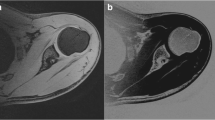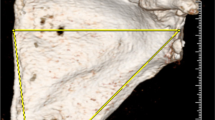Abstract
Purpose
This study evaluated the agreement between 2D and 3D computed tomography (CT) measurements in identifying the size and type of glenoid-bone defect in anterior glenohumeral instability.
Materials and methods
One hundred patients affected by unilateral anterior glenohumeral instability underwent a CT of both shoulders. Images were processed with both 2D [multiplanar reconstruction (MPR)] and 3D [volumerendering (VR)] methods. The area of the missing glenoid was calculated in comparison with the healthy glenoid and expressed as a percentage. Agreement between the two measurements was assessed according to the Bland-Altman method; a 5% mean difference was considered as clinically relevant.
Results
Analysis of agreement between MPR and VR measurements of the percentage of missing glenoid showed a mean difference equal to 0.62%±1.96%. Percent agreement between the two measurements in detecting the presence of bone defect was 97% (p<0.0001). Percent agreement between the two measurements in discriminating the type of bone defect was 97% (p<0.0001).
Conclusions
Agreement between 2D (MPR) and 3D (VR) CT measurements to identify the size and type of glenoid-bone defect in anterior glenohumeral instability was so high that the two measurements can be considered interchangeable.
Riassunto
Obiettivo
Scopo del nostro lavoro è stato valutare la concordanza tra misurazioni bidimensionali (2D) e tridimensionali (3D) con tomografia computerizzata (TC) nella identificazione delle dimensioni e del tipo di difetto osseo di glena nell’instabilità gleno-omerale anteriore.
Materiali e metodi
Cento pazienti con instabilità glenoomerale anteriore monolaterale hanno eseguito esame TC delle spalle. Le immagini sono state riformate sia con il metodo 2D (multi-planar reconstruction, MPR) che 3D (volume rendering technique, VRT). L’area del difetto di glena è stata calcolata in confronto con la glena sana ed è stata espressa in percentuale. La concordanza tra le due misurazioni è stata valutata con il metodo Bland-Altman; una differenza media del 5% è stata considerata clinicamente significativa.
Risultati
L’analisi della concordanza tra le misurazioni MPR e VRT della percentuale di glena mancante ha mostrato una differenza media di 0,62%±1,96%. La concordanza percentuale tra le due misurazioni nel valutare la grandezza del difetto osseo è stata del 97% (p<0,0001). La concordanza percentuale nel discriminare il tipo di difetto osseo è stata del 97% (p<0,0001).
Conclusioni
La concordanza tra misurazioni TC 2D (MPR) e 3D (VRT) nell’identificare le dimensioni ed il tipo di difetto osseo di glena nell’instabilità glenoomerale anteriore è stata cosÌ alta da poterle considerare intercambiabili.
Similar content being viewed by others
References/Bibliografia
Burkhart SS, De Beer JF, Tehrany AM, Parten PM (2002) Quantifying glenoid bone loss arthroscopically in shoulder instability. Arthroscopy 18:488–491. DOI 10.1053/jars.2002.32212
Gerber C, Nyffeler RW (2002) Classification of glenohumeral joint instability. Clin Orthop Rel Res 400:65–78
Greis PE, Scuderi MG, Mohr A et al (2002) Glenohumeral articular contact areas and pressures following labral and osseous injury to the anteroinferior quadrant of the glenoid. J Shoulder Elbow Surg 11:442–451. DOI 10.1067/mse.2002.124526
Itoi E, Lee SB, Berglund LJ et al (2000) The effect of a glenoid defect on anteroinferior stability of the shoulder after Bankart repair: a cadaveric study. J Bone Joint Surg Am 82:35–46
Montgomery WH Jr, Wahl M, Hettrich C et al (2005) Antero-inferior bonegrafting can restore stability in osseous glenoid defects. J Bone Joint Surg Am 87:1972–1977. DOI 10.2106/JBJS.D.02573
Balg F, Boileau P (2007) The instability severity index score. A simple pre-operative score to select patients for arthroscopic or open shoulder stabilisation. J Bone Joint Surg Br 89:1470–1477. DOI 10.1302/0301-620X.89B11.18962
Bigliani LU, Newton PM, Steinmann SP et al (1998) Glenoid rim lesions associated with recurrent anterior dislocation of the shoulder. Am J Sports Med 26:41–45
Boileau P, Villalba M, Henry JY et al (2006) Risk factors for recurrence of shoulder instability after arthroscopic Bankart repair. J Bone Joint Surg Am 88:1755–1763. DOI 10.2106/JBJS.E.00817
Burkhart SS, De Beer JF (2000) Traumatic glenohumeral bone defects and their relationship to failure of arthroscopic Bankart repairs: significance of the inverted-pear glenoid and the humeral engaging Hill-Sachs lesion. Arthroscopy 16:677–694. DOI 10.1053/jars.2000.17715
Tauber M., Resch H (2004) Reason for failure after surgical repair of anterior shoulder instability. J Shoulder Elbow Surg 13:278–285. DOI 10.1016/j. jse.2004.01.008
Bushnell BD, Creighton RA, Herring MM (2008) Bony instability of the shoulder. Arthroscopy 24:1061–1073. DOI 10.1016/j.arthro.2008.05.015
Chen AL, Hunt SA, Hawkins RJ, Zuckerman JD (2005) Management of bone loss associated with recurrent anterior glenohumeral instability. Am J Sports Med 33:912–925. DOI 10.1177/0363546505277074
Edwards TB, Boulahia A, Walch G (2003) Radiographic analysis of bone defects in chronic anterior shoulder instability. Arthroscopy 19:732–739. DOI 10.1016/S0749-8063(03)00684-4
Griffith JF, Antonio GE, Tong CW, Ming CK (2003) Anterior shoulder dislocation: quantification of glenoid bone loss with CT. AJR Am J Roentgenol 180:1423–1430
Huijsmans PE, Haen PS, Kidd M et al (2007) Quantification of a glenoid defect with three-dimensional computed tomography and magnetic resonance imaging: a cadaveric study. J Shoulder Elbow Surg 16:803–809. DOI 10.1016/j.jse.2007.02.115
Itoi E, Lee SB, Amrami KK et al (2003) Quantitative assessment of classic anteroinferior bony Bankart lesions by radiography and computed tomography. Am J Sports Med 31:112–118
Pavlov H, Warren RF, Weiss CB Jr (1985) The roentgenographic evaluation of anterior shoulder instability. Clin Orthop Rel Res 194:153–158
Saintmard B, Lecouvet F, Rubini A, Dubuc JE (2009) Is the bare spot a valid landmark for glenoid evaluation in arthroscopic Bankart surgery? Acta Orthop Belg 75:736–742
Sugaya H, Moriishi J, Dohi M et al (2003) Glenoid rim morphology in recurrent anterior glenohumeral instability. J Bone Joint Surg Am 85:878–884
Barchilon VS, Kotz E, Barchilon Ben-Av M et al (2008) A simple method for quantitative evaluation of the missing area of the anterior glenoid in anterior instability of the glenohumeral joint. Skeletal Radiol 37:731–736. DOI 10.1007/s00256-008-0506-8
Chuang TY, Adams CR, Burkhart SS (2008) Use of preoperative threedimensional computed tomography to quantify glenoid bone loss in shoulder instability. Arthroscopy 24:376–382. DOI 10.1016/j.arthro.2007.10.008
Saito H, Itoi E, Sugaya H et al (2005) Location of the glenoid defect in shoulders with recurrent anterior dislocation. Am J Sports Med 33:889–893. DOI 10.1177/0363546504271521
Stevens KJ, Preston BJ, Wallace WA, Kerslake RW (1999) CT and 3D reconstructions of shoulders with anterior glenohumeral instability. Clin Anat 12:326–336
Baudi P, Righi P, Bolognesi D et al (2005) How to identify and calculate glenoid bone deficit. Chir Organi Mov 90:145–152
Griffith JF, Antonio GE, Yung PS et al (2008) Prevalence, pattern, and spectrum of glenoid bone loss in anterior shoulder dislocation: CT analysis of 218 patients. AJR Am J Roentgenol 190:1247–1254. DOI 10.2214/AJR.07.3009
Griffith JF, Yung PS, Antonio GE et al (2007) CT compared with arthroscopy in quantifying glenoid bone loss. AJR Am J Roentgenol 189:1490–1493. DOI 10.2214/AJR.07.2473
Magarelli N, Milano G, Sergio P et al (2009) Intra-observer and interobserver reliability of the ‘Pico’ computed tomography method for quantification of glenoid bone defect in anterior shoulder instability. Skeletal Radiol 38:1071–1075. DOI 10.1007/s00256-009-0719-5
Bland JM (2003) How can I decide the sample size for a study of agreement between two methods of measurement? http://www.users.york.ac.uk/~mb55/meas/sizemeth.htm. Accessed April 2011
Bland JM, Altman DG (1986) Statistical methods for assessing agreement between two methods of clinical measurement. Lancet 8:307–310
Jankauskas L, Rüdiger HA, Pfirrmann CW et al (2010) Loss of the sclerotic line of the glenoid on anteroposterior radiographs of the shoulder: a diagnostic sign for an osseous defect of the anterior glenoid rim. J Shoulder Elbow Surg 19:151–156. DOI 10.1016/j.jse.2009.04.013
De Wilde LF, Berghs BM, Audenaert E et al (2004) About the variability of the shape of the glenoid cavity. Surg Radiol Anat 26:54–59. DOI 10.1007/s00276-003-0167-1
Aigner F, Longato S, Fritsch H, Kralinger F (2004) Anatomical considerations regarding the “bare spot” of the glenoid cavity. Surg Radiol Anat 26:308–311. DOI 10.1007/s00276-003-0217-8
Huysmans PE, Haen PS, Kidd M et al (2006) The shape of the inferior part of the glenoid: a cadaveric study. J Shoulder Elbow Surg 15:759–763. DOI 10.1016/j.jse.2005.09.001
Kralinger F, Aigner F, Longato S et al (2006) Is the bare spot a consistent landmark for shoulder arthroscopy? A study of 20 embalmed glenoids with 3-dimensional computed tomographic reconstruction. Arthroscopy 22:428–432. DOI 10.1016/j.arthro.2005.12.006
Provencher MT, Detterline AJ, Ghodadra N et al (2008) Measurement of glenoid bone loss: a comparison of measurement error between 45 degrees and 0 degrees bone loss models and with different posterior arthroscopy portal locations. Am J Sports Med 36:1132–1138. DOI 10.1177/0363546508316041
Stoller D, Shellock FG, Crues JV (1996) MRI of the shoulder: a rational approach to the reporting of findings. J Magn Reson Imaging 6:268–270
Willemsen UF, Wiedemann E, Brunner U et al (1998) Prospective evaluation of MR arthrography performed with high-volume intraarticular saline enhancement in patients with recurrent anterior dislocations of the shoulder. AJR Am J Roentgenol 170:79–84
Diederichs G, Seim H, Meyer H et al (2008) CT-based patient-specific modeling of glenoid rim defects: a feasibility study. AJR Am J Roentgenol 191:1406–1411. DOI 10.2214/AJR.08.1091
Jeske HC, Oberthaler M, Klingensmith M et al (2009) Normal glenoid rim anatomy and the reliability of shoulder instability measurements based on intrasite correlation. Surg Radiol Anat 31:623–625. DOI 10.1007/s00276-009-0492-0
Author information
Authors and Affiliations
Corresponding author
Rights and permissions
About this article
Cite this article
Magarelli, N., Milano, G., Baudi, P. et al. Comparison between 2D and 3D computed tomography evaluation of glenoid bone defect in unilateral anterior gleno-humeral instability. Radiol med 117, 102–111 (2012). https://doi.org/10.1007/s11547-011-0712-7
Received:
Accepted:
Published:
Issue Date:
DOI: https://doi.org/10.1007/s11547-011-0712-7




